 W
WThe Asian black bear, also known as the Asiatic black bear, moon bear and white-chested bear, is a medium-sized bear species native to Asia that is largely adapted to an arboreal lifestyle. It lives in the Himalayas, in the northern parts of the Indian subcontinent, the Korean Peninsula, northeastern China, the Russian Far East, the Honshū and Shikoku islands of Japan, and Taiwan. It is classified as vulnerable by the International Union for Conservation of Nature (IUCN), mostly because of deforestation and hunting for its body parts. Although largely herbivorous, Asian black bears can be very aggressive toward humans, who frequently trap or kill them for traditional medicine.
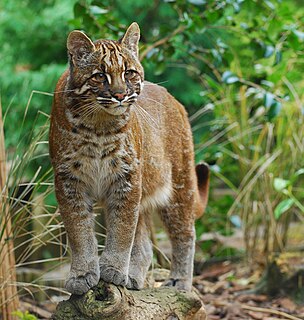 W
WThe Asian golden cat is a medium-sized wild cat native to the northeastern Indian subcontinent, Southeast Asia, and southern China. It has been listed as Near Threatened on the IUCN Red List since 2008, and is threatened by hunting pressure and habitat loss, since Southeast Asian forests are undergoing the world's fastest regional deforestation.
 W
WThe banded linsang is a linsang, a tree-dwelling carnivorous mammal native to the Sundaic region of Southeast Asia.
 W
WThe banded palm civet, also called banded civet, is a viverrid native to Myanmar, Peninsular Malaysia, peninsular Thailand and the Sunda Islands of Sipura, Sumatra and Borneo. It is listed as Near Threatened on the IUCN Red List because of its large geographic and elevation range and tolerance to some habitat disturbance.
 W
WThe bay cat, also known as Borneo bay cat and Bornean bay cat, is a small wild cat endemic to the island of Borneo that appears to be relatively rare compared to sympatric wild cats, based on the paucity of historical, as well as recent records. Since 2002, it has been listed as Endangered on the IUCN Red List because it is estimated that fewer than 2,500 mature individuals exist, and that the population declined in the past. The bay cat has been recorded as rare and seems to occur at relatively low density, even in pristine habitat.
 W
WThe sun bear is a species in the family Ursidae occurring in the tropical forests of Southeast Asia. It is the smallest bear, standing nearly 70 centimetres at the shoulder and weighing 25–65 kilograms. It is stockily built, with large paws, strongly curved claws, small rounded ears and a short snout. The fur is generally jet-black, but can vary from grey to red. Sun bears get their name from the characteristic orange to cream coloured chest patch. Its unique morphology—inward-turned front feet, flattened chest, powerful forelimbs with large claws—suggests adaptations for climbing.
 W
WThe binturong, also known as bearcat, is a viverrid native to South and Southeast Asia. It is uncommon in much of its range, and has been assessed as Vulnerable on the IUCN Red List because of a declining population trend that is estimated at more than 30% since the mid 1980s.
 W
WThe Bornean clouded leopard is a subspecies of the Sunda clouded leopard. It is native to the island of Borneo, and differs from the Batu-Sumatran clouded leopard in the shape and frequency of spots, as well as in cranio-mandibular and dental characters. In 2017, the Cat Classification Taskforce of the Cat Specialist Group recognized the validity of this subspecies.
 W
WThe Bornean ferret-badger, also known as Everett's ferret-badger or the Kinabalu ferret-badger, is a member of the family Mustelidae. The scientific name commemorates British colonial administrator and zoological collector Alfred Hart Everett.
 W
WThe Bornean tiger is possibly an extinct tiger population that is thought to have lived in the Sunda island of Borneo in prehistoric times. While a live Bornean tiger has not been conclusively recorded, indigenous people believe in its existence.
 W
WThe large-spotted civet is a viverrid native to Southeast Asia that is listed as Endangered on the IUCN Red List.
 W
WThe Asian palm civet is a viverrid native to South and Southeast Asia. Since 2008, it is IUCN Red Listed as Least Concern as it accommodates to a broad range of habitats. It is widely distributed with large populations that in 2008 were thought unlikely to be declining. In Indonesia, it is threatened by poaching and illegal wildlife trade; buyers use it for the increasing production of kopi luwak, a form of coffee that involves ingestion and excretion of the beans by the animal.
 W
WThe clouded leopard is a medium-sized wild cat occurring from the Himalayan foothills through mainland Southeast Asia into southern China. Since 2008, it is listed as Vulnerable on the IUCN Red List. Its total population is suspected to be fewer than 10,000 mature individuals, with a decreasing population trend, and no single population numbering more than 1,000 adults.
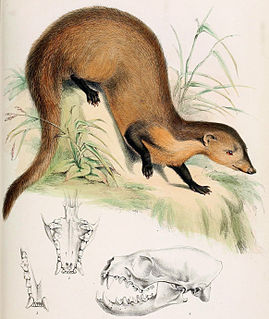 W
WThe collared mongoose is a mongoose species native to Borneo and Sumatra; its presence in the Philippines is uncertain. It is listed as Near Threatened on the IUCN Red List.
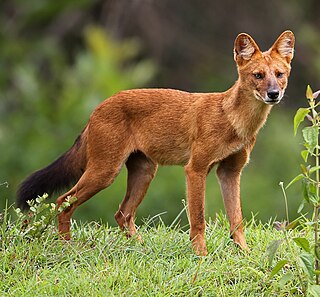 W
WThe dhole is a canid native to Central, South, East, and Southeast Asia. Other English names for the species include Asian wild dog, Asiatic wild dog, Indian wild dog, whistling dog, red dog, and mountain wolf. It is genetically close to species within the genus Canis, but distinct in several anatomical aspects: its skull is convex rather than concave in profile, it lacks a third lower molar and the upper molars sport only a single cusp as opposed to between two and four. During the Pleistocene, the dhole ranged throughout Asia, Europe, and North America but became restricted to its historical range 12,000–18,000 years ago.
 W
WThe flat-headed cat is a small wild cat native to the Thai-Malay Peninsula, Borneo, and Sumatra. It is an Endangered species, because the wild population probably comprises fewer than 2,500 mature individuals, with small subpopulations of no more than 250 adults. The population inhabits foremost wetlands, which are being destroyed and converted. For these reasons, it is listed on the IUCN Red List since 2008.
 W
WThe hog badger, also known as the greater hog badger, is a terrestrial mustelid native to Central and Southeast Asia. It is listed as Vulnerable in the IUCN Red List of Threatened Species because the global population is thought to be declining due to high levels of poaching.
 W
WHose's palm civet, also known as Hose's civet, is a viverrid species endemic to the island of Borneo. It is listed on the IUCN Red List as Vulnerable because of an ongoing population decline, estimated to be more than 30% over the last three generations and suspected to be more than 30% in the next three generations due to declines in population inferred from habitat destruction and degradation.
 W
WThe Indochinese leopard is a leopard subspecies native to mainland Southeast Asia and southern China. In Indochina, leopards are rare outside protected areas and threatened by habitat loss due to deforestation as well as poaching for the illegal wildlife trade. The population trend is suspected to be decreasing. As of 2016, the population is thought to comprise 973–2,503 mature individuals, with only 409–1,051 breeding adults. The historical range has decreased by more than 90%.
 W
WThe Javan mongoose or small Indian mongoose is a mongoose species native to South and Southeast Asia that has also been introduced to many regions of the world.
 W
WThe large Indian civet is a viverrid native to South and Southeast Asia. It is listed as Least Concern on the IUCN Red List. The global population is considered decreasing mainly because of trapping-driven declines in heavily hunted and fragmented areas, notably in China, and the heavy trade as wild meat.
 W
WThe leopard cat is a small wild cat native to continental South, Southeast, and East Asia. Since 2002 it has been listed as Least Concern on the IUCN Red List as it is widely distributed although threatened by habitat loss and hunting in parts of its range.
 W
WThe Malayan civet, also known as the Malay civet and Oriental civet, is a viverrid native to the Malay Peninsula and the islands of Sumatra, Bangka, Borneo, the Riau Archipelago, and the Philippines. It is listed as "Least Concern" by IUCN as it is a relatively widely distributed, appears to be tolerant of degraded habitats, and occurs in a number of protected areas.
 W
WThe Malayan weasel or Malay weasel is a weasel species native to the Malay Peninsula and the islands of Sumatra and Borneo. It is listed as Least Concern on the IUCN Red List.
 W
WThe marbled cat is a small wild cat native from the eastern Himalayas to Southeast Asia, where it inhabits forests up to 2,500 m (8,200 ft) altitude. As it is present in a large range, it has been listed as Near Threatened on the IUCN Red List since 2015.
 W
WThe masked palm civet, also called the gem-faced civet, is a palm civet species native to the Indian subcontinent and Southeast Asia. It has been listed as least concern on the IUCN Red List since 2008 as it occurs in many protected areas, is tolerant to some degree of habitat modification, and widely distributed with presumed large populations that are unlikely to be declining.
 W
WThe crab-eating mongoose is a mongoose species ranging from the northeastern Indian subcontinent and Southeast Asia to southern China and Taiwan. It is listed as Least Concern on the IUCN Red List.
 W
WThe otter civet is a semiaquatic viverrid native to Thailand, Malaysia, Indonesia and Brunei. It is listed as Endangered because of a serious ongoing population decline, estimated to be more than 50% over the past three generations, inferred from direct habitat destruction, and indirect inferred declines due to pollutants.
 W
WThe hairy-nosed otter is a semiaquatic mammal endemic to Southeast Asia and one of the rarest and least known otter species. It is threatened by loss of natural resources and poaching.
 W
WThe Asian small-clawed otter, also known as the oriental small-clawed otter or simply small-clawed otter, is a semiaquatic mammal native to South and Southeast Asia. This species is a member of the otter subfamily (Lutrinae) of the weasel family (Mustelidae), and is the smallest otter species in the world. Its paws are a distinctive feature; its claws do not extend beyond the fleshy end pads of its partially webbed fingers and toes. This gives it a high degree of manual dexterity so that it can use its paws to feed on molluscs, crabs and other small aquatic animals.
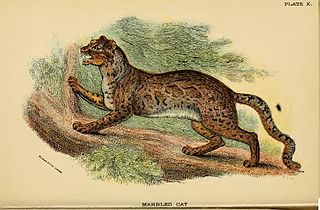 W
WPardofelis is a genus of the cat family Felidae. This genus is defined as including one species native to Southeast Asia: the marbled cat. Two other species, formerly classified to this genus, now belong to the genus Catopuma.
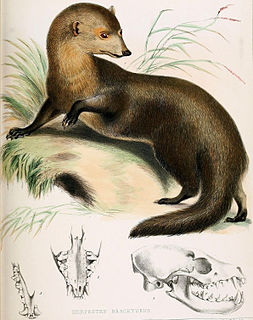 W
WThe short-tailed mongoose is a mongoose species native to Peninsular Malaysia, Sumatra and Borneo. It inhabits evergreen forest and rural gardens from sea level to an elevation of 1,500 m (4,900 ft). It is listed as Near Threatened on the IUCN Red List since 2008.
 W
WThe small Indian civet is a civet native to South and Southeast Asia. It is listed as Least Concern on the IUCN Red List because of its widespread distribution, widespread habitat use and healthy populations living in agricultural and secondary landscapes of many range states.
 W
WThe small-toothed palm civet, also known as the three-striped palm civet, is a palm civet native to dense forests of Southeast Asia, from the Assam district of India to Indochina and the Malay Peninsula and on Sumatra, Bangka, Java, Borneo, and numerous small nearby islands of Indonesia.
 W
WThe smooth-coated otter is an otter species occurring in most of the Indian subcontinent and Southeast Asia, with a disjunct population in Iraq. It is listed as Vulnerable on the IUCN Red List since 1996 and is threatened by habitat loss, pollution of wetlands and poaching for the illegal wildlife trade. As its name indicates, its fur is smooth and shorter than that of other otter species.
 W
WThe Sunda clouded leopard is a medium-sized wild cat native to Borneo and Sumatra. It is listed as Vulnerable on the IUCN Red List since 2015, as the total effective population probably consists of fewer than 10,000 mature individuals, with a decreasing population trend. On both Sunda islands, it is threatened by deforestation.
 W
WThe Sunda stink badger, also called the Javan stink badger, teledu, Malay stink badger, Malay badger, Indonesian stink badger and Sunda skunk, is a mammal native to Indonesia and Malaysia. Despite the common name, stink badgers are not closely related to true badgers, and are, instead, Old World relatives of the skunks.
 W
WThe tiger is the largest extant cat species and a member of the genus Panthera. It is most recognisable for its dark vertical stripes on orange-brown fur with a lighter underside. It is an apex predator, primarily preying on ungulates such as deer and wild boar. It is territorial and generally a solitary but social predator, requiring large contiguous areas of habitat, which support its requirements for prey and rearing of its offspring. Tiger cubs stay with their mother for about two years, before they become independent and leave their mother's home range to establish their own.
 W
WThe Malayan tiger is a tiger from a specific population of the Panthera tigris tigris subspecies that is native to Peninsular Malaysia. This population inhabits the southern and central parts of the Malay Peninsula and has been classified as critically endangered on the IUCN Red List in 2015. The population was estimated at 250 to 340 adult individuals in 2013 and likely comprises less than 200 mature breeding individuals and has a declining trend.
 W
WThe yellow-throated marten is a marten species native to Asia. It is listed as Least Concern on the IUCN Red List due to its wide distribution, evidently relatively stable population, occurrence in a number of protected areas, and lack of major threats.